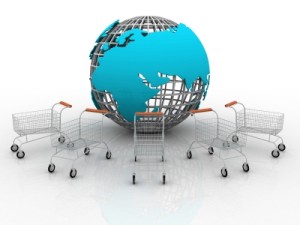Alibaba’s $9.34 billion day: implications for cross-border e-commerce
 Guess which of the following is the biggest online shopping day of the year worldwide?
Guess which of the following is the biggest online shopping day of the year worldwide?
- Black Friday
- Cyber Monday
- Valentine’s Day
- Boxing Day
- Veterans Day/Remembrance Day
If you guessed anything but 5, you would be wrong.
That’s right, November 11th, known in many North American and European countries as a day to honor veterans, is Singles’ Day in China. A sort of anti-Valentine’s Day, Singles’ Day is when people in China, not in a relationship, buy gifts for themselves. On Singles’ Day this year, Chinese consumers spent $9.34 billion on the popular commerce site Alibaba alone (Alibaba accounts for about 80 percent of online sales in China).
The cross-border e-tail opportunity
To put the Singles’ Day figure into perspective, here are some additional stats:
- In the U.S., depending on the source, total online sales on Cyber Monday in 2013 were between $1.8 billion (Comscore) to $2.2 billion (Adobe).
- The same day, known as Mega Monday in the UK, generated an estimated £450 million (Visa Europe), which equates to nearly $800 million USD.
In other words, even if the combined 2013 sales on one of the largest online shopping days in two of the countries with the highest rates of online shopping doubled in 2014, they still would not come close to the amount spent on Singles’ Day in China.
If you are an online retailer in a country with a fairly mature e-commerce market, or if you think you have tapped out your potential addressable market at home, the prospect of accessing a new $9 billion market should be pretty appealing. The good news is that it is becoming easier to do so; not just in China, but in other markets around the globe as well.
Multiple paths exist to cross-border e-commerce maturity
To be sure, it is still a frustrating, unpredictable, and frequently expensive experience for customers who want to buy online from international retailers. Often they must contend with clunky web interfaces, unexpected additional delivery and duty fees, a slow and expensive shipping process, and an unclear and complex returns process. If your e-commerce site currently suffers from these or other issues that result in a sub-par customer experience, there are solutions out there, regardless of whether you design jewelry in your kitchen or are a sought-after multi-million dollar brand.
With the vast and varied landscape of potential partners available to help retailers fill in the gaps in their own expertise, there is no excuse for why even those with the smallest budgets can’t offer their customers a great e-commerce experience. No matter where you are in your level of e-commerce development, there is the right partner out there who can help you with site optimization, payment solutions, customs and duty solutions, logistics and delivery solutions, or any combination of those and more. A mom-and-pop shop can turn to various marketplaces (eBay, Tmall in China, Mercadolibre in Latin America), while a sophisticated luxury brand can engage with global agencies, systems integrators, global delivery companies, specialists in supply-chain management, and many more to supplement their capabilities.
Measure twice, cut once
To figure out what kind of partner you’ll need, you first have to figure out where you are along the spectrum of cross-border e-commerce maturity. The larger your goal, the more important it will be for you to identify the right partners to fill the gaps in your capabilities and alert you to the potential opportunities and pitfalls ahead. It is well worth the time needed to figure this out, and to talk to a range of prospective partners. Maintaining a stasis and not venturing into cross-border e-commerce puts those retailers are at risk of losing out twice: once on losing out on potential growth opportunities abroad, and then again on the potential of losing existing market share at home as new international players begin to enter their backyards.
To learn more about cross-border e-commerce and how retailers can assess their level of maturity in order to select the appropriate partners, click here for a free download of our new Insight paper: Cross-Border E-Commerce: A Maturity Roadmap and Partner Selection Guide (registration required).








